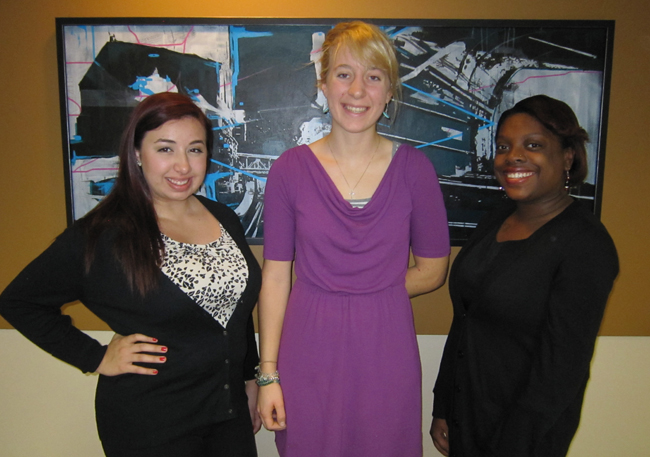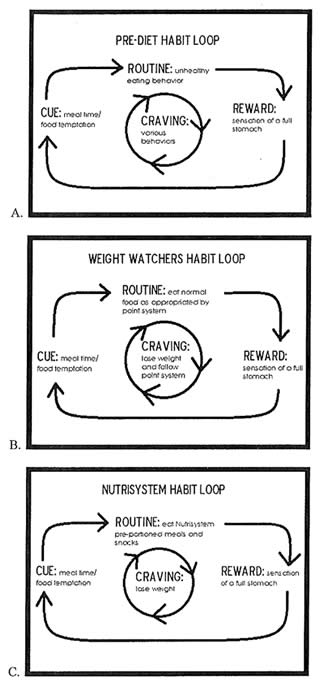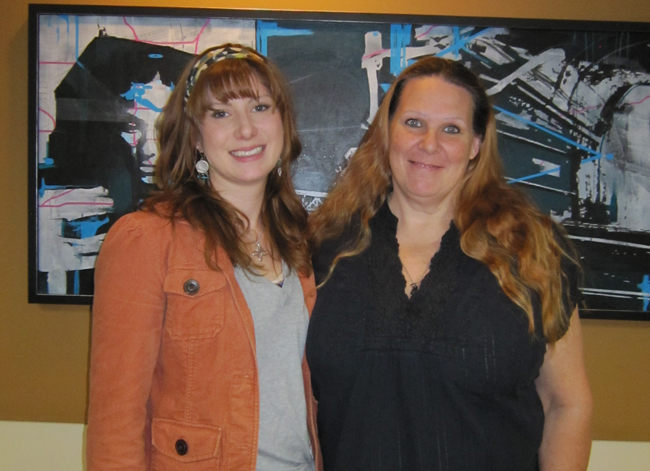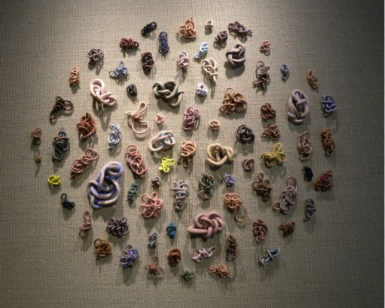Reader Program Announces Contest Winners
Nov. 7, 2013
SHSU Media Contact: Jennifer Gauntt
The First-Year Experience Office has recognized 10 students for their outstanding work in its three Bearkats Read To Succeed Freshman Essay, Poetry and Art contests, coinciding with this year's BRTS Author's Forum for the common reader selection The Power of Habit, by Charles Duhigg. Below are the winners and their submissions in each competition.
Freshman Essay Contest
 |
| (From left) Alondra Garza, the $500 scholarship winner, and honorable mention recipients Rebekah Scholz and Alexis Johnson. |
For the freshman essay contest, sponsored by New Student Orientation, freshmen were asked to analyze an advertising or political campaign, a government or nonprofit program, or a self-improvement program in terms of how the campaign targeted consumers or has the potential to to change habits, as explained in The Power of Habit. The winning essay, which was awarded a $500 scholarship, was written by criminal justice major Alondra Garza. Her essay, "The Power of Habit," examined her, and society's, penchant for fast food. Honorable mention recognitions were awarded to criminal justice major Alexis Johnson, whose essay "Narcotics Anonymous: A Fellowship with a Mission" examined the 12 step program; and English major Rebekah Scholz, whose essay "Kicking Away the Pounds and Taking New Habits" compared the Nutrisystem and WeightWatchers programs. Their essays are below, in their entirety.
"Power of Habit" by Alondra Garza
Everyday life revolves around imperative habits that we have developed, either consciously or sub-consciously, because these habits are the foundation that allows us to function on a regular basis. Habits are all around us, from the time we wake up immediately checking our smart phones, to what we eat, how we study, and how we interact with others. As consumers, habits reel us in, causing us to shop at a particular store or to dine at the same restaurant multiple times. As Charles Duhigg explains in “The Power of Habit,” habits become consistent when there is an exchange that results in the individual receiving a reward. This is the key to how a franchise like McDonald’s, is the most successful fast food chain; McDonald’s gives consumers what they want which keeps them coming back for more, thus creating an unbreakable habit loop.
Perhaps what we as consumers associate most with a restaurant chain like McDonald’s is their “fast” food service. Efficiently made food attracts consumers and locks them in with what is known as the habit loop. The average American family practices a very fast-paced way of living. The day is filled with school, work, soccer practices and other activities that leave a minute amount of time to dedicate to a sit down family style dinner. The cue becomes the frantic panic faced across the nation, debating what to make for dinner with what little time there is. With their speedy service, McDonald’s, perhaps once a week, is seen as the solution to this problem. Consumers habitually go through the convenient drive thru, get their food, and go home in less time than it takes to even prepare dinner, much less eat it. The reward is simply spending somewhat more time with their family because McDonald’s granted that privilege. The ability to make and serve a customer in a matter of just minutes is appealing to most Americans and it is crucial to McDonald’s to implant this habit loop in Americans to continue their success throughout the future generations of consumers.
Another habit loop formed by McDonald’s involves an emotional reward. The cue this time is achievement. Parents like to reward their children for getting excellent marks or for hitting the winning homerun. A way to celebrate is to treat kids with their favorite meal and some dessert at the local McDonald’s. Why? Not only do the parents recall how fast the service is, but now the kids begin to associate McDonald’s with fulfillment and happiness. McDonald’s provides some time for families to eat together, so it is no different than going to McDonald’s now is a reward for accomplishing something. The cue is achieving something, the habit becomes going to McDonald’s, and the reward is emotional appeal filling the consumer with a sense of happiness now associated with McDonald’s.
Yet another habit loop that entraps American consumers is how McDonald’s provides a “babysitting” service per say. Parents are sometimes filled with the daily stress of everyday life, their work, and managing their children. The cue is the stress that comes with having young children bursting with energy bouncing off the walls. The habit becomes taking them to the local McDonald’s because there is not only food, but typically a playground for kids that allows for play time. The reward is for both the children and parents: the children get to play and run off their energy, while the parents earn a small amount of relaxation time after their meal. This becomes almost a practice, and it becomes so habitual that whenever parents want to “babysit” their kids while they get some spare time, they just travel to the closest McDonald’s.
Restaurants like McDonald’s are aware of the habits that form which allow consumers to make weekly trips. Consumers are the ones who need to be conscious of the decisions they are making because habits like these dictate not only where their hard earned money is spent, but also what they are feeding their bodies. Habits run our lives, they can be adventitious habits, or they can be habits that have negative effects. It is our duty as consumers to decide what habits are included in our day to day living and to take responsibility for the well-being of ourselves and the future of America.
"Narcotics Anonymous, a Fellowship with a Mission," by Alexis Johnson
Why is it that organizations have the potential to effectively change habits of individuals who cannot change their own habits? Organizations have changed habits that people have unsuccessfully tried to change for years. It is quite peculiar how other people have the power to change habits of others without knowing them personally, but it has been proven by many that in order to recreate a habit, a new routine needs to be inserted between the cue and the reward, a sense of community needs to be created, and a sense of spiritual guidance needs to be sought (92). An organization known as Narcotics Anonymous (NA) has helped its member change their habits by following the guidelines in The Power of Habit. NA has the potential to change habits, because this organization recreates habits by inserting new routines that have steps that help break down the habit, create a community that works as a support system, and encourage spiritual understanding.
NA states that its mission is, “to provide an environment in which addicts can help one another stop using drugs and find a new way to live life” (Narcotics Anonymous, “Information” 1). In order to provide an environment in which NA can achieve its mission, the organization holds group meetings. In these group meetings members are able to share how they are managing a drug addiction free life as well as share challenges they face. Narcotics Anonymous also stated that, “by remaining free from the distraction of controversy, NA is able to focus all of its energy on its particular area of purpose” (Narcotics Anonymous “Information” 1). By staying in the neutral zone of different issues related to drug usage, Narcotics Anonymous is able to tend to its members in the way that is needed.
With the mission of helping its members live an active drug free life in mind Narcotics Anonymous creates lifestyle-changing habits. This organization created what it calls the Twelve Steps and Twelve Traditions of Narcotics Anonymous. These Twelve Steps and Twelve Traditions that NA enforces use the same method that Tony Dungy applied to the NFL team, the Buccaneers, in order to turn them into “one of the league’s winningest teams (Duhigg 63). Both Narcotics Anonymous and Tony Dungy applied the Golden Rule of habit change, they “kept the old cue, and deliver the old reward, but insert a new routine” (62). By inserting the Twelve Steps and Traditions into already existing habits of members, NA has the potential help members be more successful in their recovery because as stated in the Power of Habit, it is “easier to convince someone to adopt a new behavior if there was something familiar at the beginning and end” (62). In using the Twelve Steps and Twelve Traditions NA also sets up a process in which it breaks down the necessary steps to help NA members overcome their addiction. NA’s members stated in How it Works, “These are the principles that made our recovery possible” (Narcotics Anonymous “How it Works” 1). When NA breaks down the recovery process into steps they create routine changes within their members, because NA has them apply the Twelve Steps and Traditions to everyday life. As a result of new routines being created by the Twelve Steps and Twelve Traditions the reconstruction of old habits is prompted. Additionally, NA group meetings also influence life-changing habits because “individual members lead the NA meetings while other members participate by sharing their experiences in recovering from drug addiction” (Narcotics Anonymous, “Information” 1). By letting the members run the meetings and share their experiences NA allows them to talk about their experiences and seek guidance from one another. The group meetings are in place in order to replace the old routine of drug usage with the new routine of attending group meetings instead as stated by NA, “we. . . meet regularly to help each other stay clean” (Narcotics Anonymous, “Information” 1).
NA’s efforts to help members recover from addiction relates to the concepts mentioned in the Power of Habit in more detailed ways than just changing lifestyle habits. NA group meetings also create a community for addicts that allow a greater opportunity for change; the same way that the Montgomery Bus Boycott was able to create a massive movement based on the black community coming together as one. The Montgomery Bus Boycott Movement showed how a group of people that shared common ties, whether strong or weak, could unite together as a community and create such a powerful bond that would eventually create positive changes. This same powerful bond of community is created within group meetings that Narcotics Anonymous hosts in that members come together and create a “peer supported network” in order to help each other overcome addiction. This powerful community bond is one of the main factors that power the change of habits in NA members, because as NA stated, “One of the key to NA’s success is the therapeutic value of addicts working with other addicts“ (Narcotics Anonymous, “Information” 1).
In addition, NA also encourages its members “to cultivate an individual understanding—religious or not— of the spiritual principles and apply these principles to everyday life” (Narcotics Anonymous, “Information” 1). This concept of seeking spiritual guidance relates to another concept mentioned in The Power of Habit. The Power of Habit indicated that “belief is essential and it grows out of a communal experience” (Duhigg 93). The Power of Habit also states that in order “for a habit to stay changed, people must believe change is possible” (92). NA helps its members create that sense of belief by encouraging them to seek spiritual guidance and providing group meetings in which the spiritual guidance can be nurtured. By applying these methods, NA carries out its mission to “provide an environment in which addicts can help one another stop using drugs and find a new way to live” (Narcotics Anonymous, “Information” 1).
NA as a whole has the potential to change many individuals’ lives. NA targets one thing it wants to change and that is the lifestyle that addicts live. NA is also successful because it provides “a recovery process and peer support network that are linked together” (Narcotics Anonymous, “Information” 1). NA’s focus on targeting change in routines, establishing a sense of community, and encouraging as well as nurturing spiritual guidance has been proven by the Power of Habit to be some of the most effective ways to create habit change not only in people but “also companies, organizations, and communities” (Duhigg 93).
"Kicking Away the Pounds and Taking New Habits," by Rebekah Scholz
Ben Franklin, master diplomat and inventor, once said, “It is easier to prevent bad habits than to break them” (“Habit Quotes”). In essence, Franklin argues that it is easier to avoid creating an undesired habit than to change one already in existence. In the book The Power of Habit, Charles Duhigg frequently comments on this idea. The basis of Duhigg’s book lies in the idea of a habit loop, which explains that changing a habit is not as easy as some may think. Duhigg explains that a change in habit, one must “keep the same cues and rewards as before, and feed the craving by inserting a new routine” (Duhigg 71). A craving can entail many behaviors, such as a desire to win or a hunger to eat dinner. A craving also holds great “powers the habit loop” (33).
Duhigg cites the story an NFL team, the Buccaneers, to illustrate this point. For 16 years, the Buccaneers were unable to win a single game on the East Coast. Yet after hiring Tony Dungy, the Buccaneers reached the playoffs for ten consecutive years because of Dungy’s strategy. He focused solely one “attack[ing] the middle step, the routine” of his players form and technique, allowing the players to refocus how they fed their craving to win (62). After Dungy’s first major win with the team, one player commented that this game had been different from the others. Dungy replies, “We’re starting to believe,” (66). This belief represented how intensely the players desired to win, which allowed them to successfully execute Dungy’s new routines. Dungy’s approach to changing habits cannot only be utilized by a football team, but also by a large corporation looking to make a profit. After studying two seemingly diverse programs, Weight Watchers and Nutrisystem, I have made conclusions regarding how these programs utilize such habits to help their customers succeed in their programs. Both programs are based upon altering the routine of eating habits and creating a desire to maintain them, suggesting the simple foundation of all habit changes.
To begin, both of these programs require that their customers want to change a habit they have. This would naturally target the eating habits of their consumers, which is exactly what both of the programs do. To understand how Weight Watchers and Nutrisystem work, one must first understand the “bad” habits of individuals who seek to lose weight through their services. These bad habits follow the pattern of the habit loop: after identifying a cue, an individual will perform a routine to attain the expected reward. For this routine to become habit, the individual must have a craving, or a desire that reinforces the routine. In general, individuals who have unhealthy eating habits do so because they have some sort of stressor, a type of craving that prevents them from eating healthy food. That stressor could entail emotional concerns, drama at work, inconvenience, a lack of self-confidence, or a combination of these concerns. For Mae, a successful customer of Weight Watchers, her concern was convenience. She craved the convenience in her meals because of time constraints and thus scarified her heath. Before committing to Weight Watchers, Mae found herself having “fast food two or three times a day sometimes” because “it was the easiest thing to do” (“How Mae Found Her Way” par, 5). This craving caused her to enact a routine of eating unhealthy foods when her cue, mealtime, materialized. She attained her reward, a full stomach, and continued in this behavior because of convenience. Shari W., a successful customer of Nutrisystem, experiences a similar pattern in her dieting efforts. After an unhappy marriage and divorce, Shari found that she did not care about other’s opinions because she “had a wonderful job, a great life, and soon enough [she] had even found and incredible new man”(”Success Stories: Shari W.” par. 1). The emotional toll of her divorce, in combination with the distractions of positive emotions, caused Shari to forget about her health as she found herself gaining weight and “slowly moving up size by size” (“success Stories: Shari W.” par.1). Like Mae, Shari’s eating habits were influenced by an outside stressor. The mixture of her emotions removed her capacity to eat healthy and thus caused her to crave unhealthy foods. She had fallen into a dangerous habit loop just like Mae. In Appendix A, I have illustrated this loop in the same way that Duhigg does in his novel, The Power of Habit. This loop applies not only to Mae and Shari, but may apply to any individual searching to eradicate their unhealthy eating habits. The question now is: how would an individual like Mae or Shari defeat this cycle of self-destructive nutrition? Weight Watchers and Nutrisystem have the answer.
 Let’s take a look at Weight Watchers first. This corporation approaches weight loss from a realistic perspective: They encourage their customers to change their eating routines so that they can lead a healthy lifestyle. Or so that they crave healthy foods all the time. On the corporation’s website, Weight Watchers challenges its customers to “train [their] brains by learning new routines and great habits, so [they] can make healthy choices without even thinking about it” (“A Revolution…” par.6). This program has a unique routine: the Points Plus system. All foods are assigned a certain amount of points based on its “protein, carbohydrates, fat, and fiber content” (“Eat what You Love…” par.4). The point system allows a dieter to choose whatever food he wants as long as he limits himself to the appropriated daily amount of food points. This amount is unique to every individual, “based on [one’s] height, weight, age and gender” (”Eat What You Love…” par.5). This structured system provides a clear routine that many individuals find convenient to use. Weight Watcher’s mass technological resources, such as an app for point tracking, also adds to this convenience. This aspect of Weight Watchers had a significant effect on Mae’s experience with the program. She said, “Having the app to track my food and look up foods and their Points Plus values was a real no-brainer” (“How Mae Found Her Way” par. 3). The convenience of this program lends itself to success because it allows individual to lose weight and beat the system, the points Plus system that is. Although not typical for all members, Mae lost 125 pounds! These types of success cause a dieter to crave the routine of following the Weight Watchers system and ultimately create a habit of healthy eating. This habit can be illustrated in a loop to. Please refer to Appendix B to see how I illustrated Weight Watcher’s habit loop, once again modeled after Duhigg’s habit loop. Weight watchers does not ask its customers to change the cue or reward of their eating habits. They do not ask their customers to skip a meal or neglect the feelings of a satisfied stomach. They simply challenge individuals to change their eating routines by following a convenient point system. After this research and interviewing a friend of mine, Amanda, I saw how beneficial this program could be. Amanda said, “I would for sure [recommend this program to others] because it’s a lifestyle change. It helps you discover how to eat healthy and maybe some unhealthy patterns you might be in.”
Let’s take a look at Weight Watchers first. This corporation approaches weight loss from a realistic perspective: They encourage their customers to change their eating routines so that they can lead a healthy lifestyle. Or so that they crave healthy foods all the time. On the corporation’s website, Weight Watchers challenges its customers to “train [their] brains by learning new routines and great habits, so [they] can make healthy choices without even thinking about it” (“A Revolution…” par.6). This program has a unique routine: the Points Plus system. All foods are assigned a certain amount of points based on its “protein, carbohydrates, fat, and fiber content” (“Eat what You Love…” par.4). The point system allows a dieter to choose whatever food he wants as long as he limits himself to the appropriated daily amount of food points. This amount is unique to every individual, “based on [one’s] height, weight, age and gender” (”Eat What You Love…” par.5). This structured system provides a clear routine that many individuals find convenient to use. Weight Watcher’s mass technological resources, such as an app for point tracking, also adds to this convenience. This aspect of Weight Watchers had a significant effect on Mae’s experience with the program. She said, “Having the app to track my food and look up foods and their Points Plus values was a real no-brainer” (“How Mae Found Her Way” par. 3). The convenience of this program lends itself to success because it allows individual to lose weight and beat the system, the points Plus system that is. Although not typical for all members, Mae lost 125 pounds! These types of success cause a dieter to crave the routine of following the Weight Watchers system and ultimately create a habit of healthy eating. This habit can be illustrated in a loop to. Please refer to Appendix B to see how I illustrated Weight Watcher’s habit loop, once again modeled after Duhigg’s habit loop. Weight watchers does not ask its customers to change the cue or reward of their eating habits. They do not ask their customers to skip a meal or neglect the feelings of a satisfied stomach. They simply challenge individuals to change their eating routines by following a convenient point system. After this research and interviewing a friend of mine, Amanda, I saw how beneficial this program could be. Amanda said, “I would for sure [recommend this program to others] because it’s a lifestyle change. It helps you discover how to eat healthy and maybe some unhealthy patterns you might be in.”
Nutrisystem helps its customers change their eating habits in a similar (but simpler) manner: a meal plan. The meal plan system forces individuals to change their eating routine without changing the cue or reward. The plan system is simple. Customers are allotted six meals and snacks a day in which they can “handpick [their] entire menu or go with [Nutrisystem’s] pre-selected favorites pack” (“How Nutrisystem…” par3). According to their website, Nutrisystem sends meals prepackaged and microwave-ready to its members, unlike Weight Watchers. And with a variety of options, customers of Nutrisystem are able to change their eating routines from unhealthy to healthy with ease. Both these aspects made Nutrisystem a positive experience for Shari W. In her success story on Nutrisystem’s website, Shari says,” There was so much food, and I was pleasantly surprised to find that it was really good! Plus, it was so convenient. There were some days that I wouldn’t get home from work until 10 at night, and instead of having to worry about what to eat I just popped my Nutrisystem in the microwave and had a good dinner” (“Success Stories: Shari W.” par.2). Shari’s experience illustrates the simplicity of the system because her habit change is easily identified by a habit loop. When Shari receives the cue of hunger, she enacts the routine of eating pre-portioned meals and then receives the award of fulfilling her hunger. The weight loss Shari experienced most definitely reinforced her new habit. The weight loss was her craving. Nutrisystem also reinforces the habits they are trying to create with motivation. The corporation’s website has a tab labeled “Tools and Community”. Here, customers have the ability to track their results and share their struggles and successes with one another (“Tools and Community” par.1). In Appendix C, I have illustrated this habit loop. This loop crafted by Nutrisystem worked for Shari as she lost 57 pounds and now testifies, “I feel like I got Shari back,”(“Success Stories: Shari W.”par.3).
In such, both Weight Watchers and Nutrisystem employ similar tactics to lure in their customers. They create a habit by following the principles of the habit loop. Neither program encourages its members to change their cues or reward for eating. Rather, both challenge its members to change the actual action of eating. However, these programs are slightly different in the way they choose to reinforce the habits they create. While Weight Watchers uses a strict point system for reinforcement, Nutrisystem relies on a less organized mode of reinforcement. Weight Watchers may appeal to an elder woman who has time each day to plan and cook meals. However, Nutrisystem may appeal to a busy mom who relies on convenience. This represents the idea that different routines work for different people even though a significant difference does not exist between the two programs. Underlying these tactics is the notion that a habit can only be altered if the routine and desire are changed, whether one seeks to score a touchdown or lose a pound.
Poetry Contest
 |
| (From left) Tamaira Walker, honorable mention; Jennifer Esmond, winner for all classifications; and Donye Pena, honorable mention. Not pictured is freshman contest winner Mickayla Staten. |
The poetry contest, sponsored by SHSU's PACE Center, asked students to write a poem or lyric about a personal habit or the habit someone else, of which they were reminded as they read The Power of Habit. Freshman English major Mickayla Staten's winning poem "How it Happened," was written with her father in mind as she wrote about the effects of smoking. Junior English major Jennifer Esmond's winning poem was called "Eugene Pauly Rises with Coffee each Day." Each won a $250 scholarship. Honorable mentions were awarded to freshman business management major Donye Pena, whose "I Have a Habit" detailed her issues with eczema; and freshman psychology major Tamaira Walker, whose "Sweet Misery" involves the habit of eating one's feelings. Their poems are below.
"How it Happened," by Mickayla Staten
Young and angry. Seventeen.
“It seems
Like fun.
No big deal.
I’ll just have one-
See how it feels.”
Breathed deep then choked,
But looked at them and smiled.
“Fake it now, like a joke.”
It won’t be faking in a while.
Older and wiser? Twenty-nine.
“I can quit at anytime.
Tomorrow, I swear.”
He heads to the store,
And they’re right there
In his mouth as soon as he’s out the door.
Breathes deep, then deeper,
Doesn’t smile.
“Fake it now. Keep her
From knowing.” He hasn’t had control in a while.
Older still and weary. Forty-one.
“After this, I’m really done.”
He puts it out.
Hours go by.
Heart races painfully. Fear and doubt
Fill his mind, and he wonders why.
Breathes but can’t breathe.
Admits it. Finally.
“Can’t fake it anymore. I need
To quit. Not just for myself.
Young and worried. Only nineteen.
I answer the phone and it seems
Like a nightmare. “Is he okay?”
In a hospital bed.
Smoked too many that day.
“He can’t be dead.”
He’s not. Not yet. “If he would just change this habit…”
But the nicotine was louder than when I said,
“Dad, please quit.”
"Eugene Pauly Rises with Coffee Each Day," by Jennifer Esmond
There is no coffee in romance,
only the idea of coffee. The smell may bring to mind
the skirts of Dickinson, but there is no warmth
in that. It does not travel
up wandering sandals and unhook
gold latches, it does not
convince bared ankles to sink into the mire
of thoughtful dispositions and Free Trade Organic Anything,
nor fill the mouth with politics and Virgil. Coffee
is much more simple than that. It reminds him
to take his bite, small portion, of banana meat
nine hours after midnight, after the bright haze
of diatomaceous thoughts hover above his bed, faint muslin
settling over his mind, nipping the memories of the time
he pressed his fingers into the clay of the coast, sank
into the chilled wetness, Lord of the Lake, fifteen
and the deep damp lava of the earth hums
above him. Far, far—
empty. It smells of roasting beans and febreeze,
wartime economics. “Time for coffee, dear,”
Beverly says over the plate of bananas.
Time for coffee.
"I have a Habit," by Donye Pena
I have a habit
A habit I call itch
Itch is a habit
A habit that is me
I itch when I’m mad
I itch when I’m nervous
I itch to soothe
Calming me down
I itch I itch I itch
Failing to realize
That blocked from the thought
Itch is a habit
A habit that is me
Me is itch
And itch is I
In which
Unconscious itch
Makes my mind go by
Failing to realize
That blocked from the thought
Itch is a habit
A habit that is me
You tell me to stop
To stop my itch
In spite of your request
It is impossible
Seeing that if I stop itch
Then I stop being me
Which you have failed to realize
That blocked from the thought
Itch is a habit
A habit that is me
"Sweet Misery," by Tamaira Walker
The black pit that runs deep,
from my heart to my stomach;
brings me closer to one thing,
that can overcome it.
A taste of a snack brightens my day,
taking each pain far away.
But, the pain returns
and the pounds multiply.
My knees start to shake
and I break down and cry.
I look in the kitchen to see what I can take,
in the fridge I find a chocolate cake.
This endless cycle is so hard to beat,
all I can do is just eat.
Art Contest
 |
| (From left) Art contest winner Laura Pregeant and honorable mention recipient Alice Cates. Not pictured is second place winner Farrah Al Sulaiman. |
The art competition, sponsored by the Lowman Student Center, encouraged students to create art based on the themes presented in the book. The winners were senior studio art major Laura Pregeant, "Best in Show," $200 scholarship winner; senior photography major Farrah Al Sulaiman, second place, $100 scholarship winner; and junior photography major Alice Cates, the honorable mention, $74 scholarship winner. Photos of the pieces are below.
 |
"Tangles," a ceramic installation by studio art major Laura Pregeant explores a habitual technique in ceramic making, with each coil representing her habit of overthinking. |
 |
"Religion," a portrait by senior photography major Farrah Al Sulaiman, is a painting created from a photograph she had taken. In it, Al Sulaiman's subject is "questioning" the religious practice of covering the face in her eyes, she said, with a Mona Lisa-style ambiguity. |
 |
"Trixie," by photography major Alice Cates, plays on the cover art of the book The Power of Habit. |
- END -
This page maintained by SHSU's Communications Office
Associate Director: Julia May
Manager: Jennifer Gauntt
Located in the 115 Administration Building
Telephone: 936.294.1836; Fax: 936.294.1834
Please send comments, corrections, news tips to Today@Sam.edu.

 SamWeb
SamWeb My Sam
My Sam E-mail
E-mail

